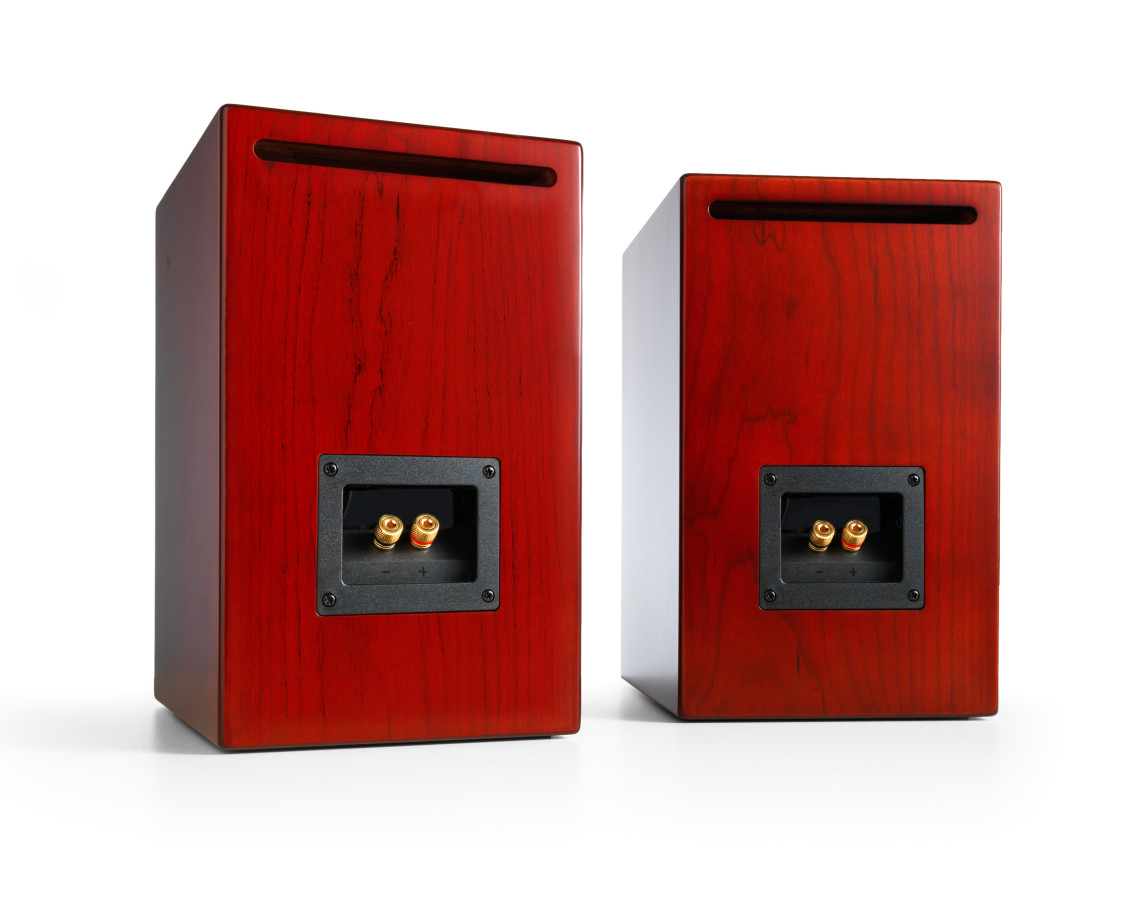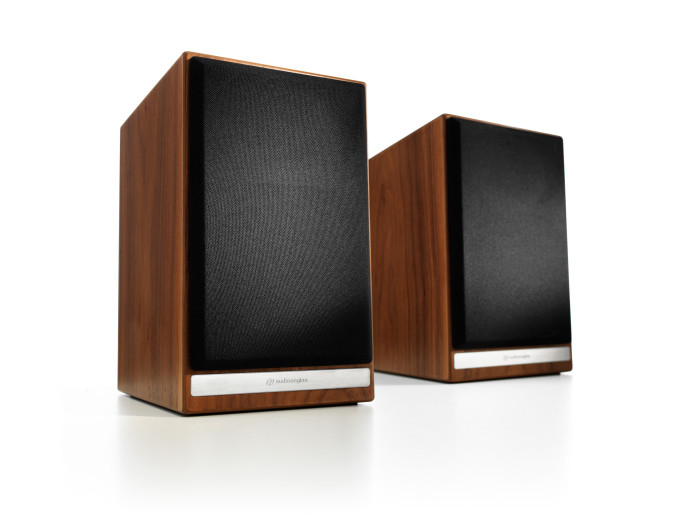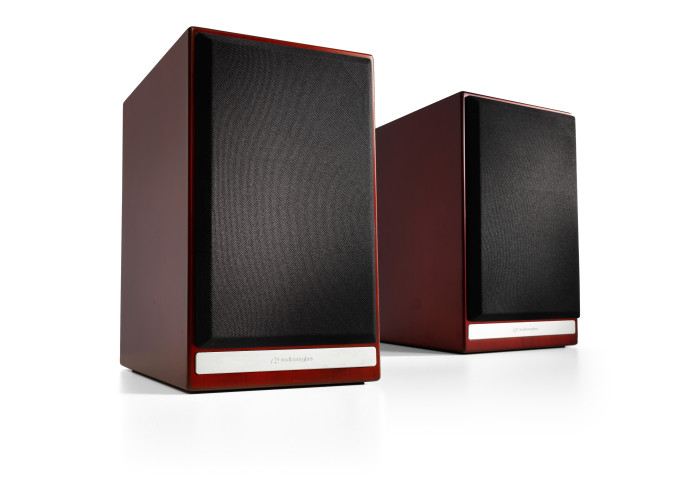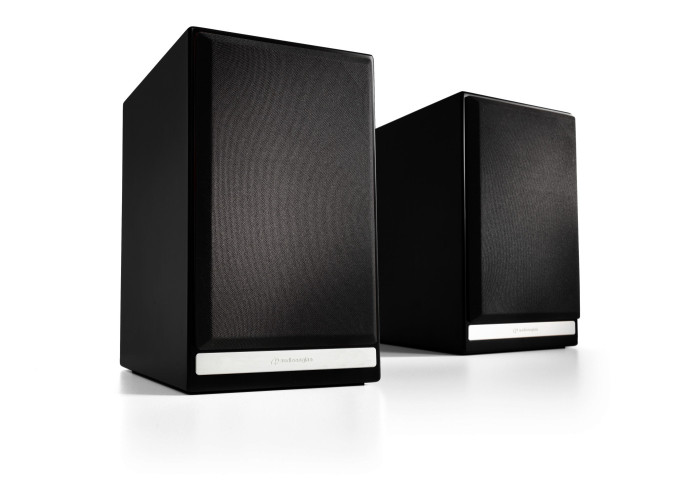The Original HD6
Recently reviewed by Dagogo Senior Reviewer Jack Roberts, the $750 Audioengine HD6 combined an internal amplifier and a version of the company’s B1 Bluetooth Premium Receiver, meaning it received Bluetooth audio wirelessly while accepting Toslink digital signal. If one only has an iPhone, just by adding the Audioengine HD6 and you’d have a complete audio system. At the same time Jack was reviewing it, I was also sent a pair for auditioning. My pair of HD6 was placed on 24-inch stands far away from wall boundaries, 6 feet apart and 6 feet from my listening couch.
The HD6’s polished, 3/4-inch thick, MDF cabinet was said to be of furniture grade veneers and extensively braced and heavily damped. The grill was detachable and “firmly held in place with hidden neodymium magnets for a clean look.” The speaker employed “audiophile-quality, ferrofluid-cooled silk dome tweeters with neodymium magnets” to provide smooth response even under high power. The woofer was “Kevlar woven glass aramid composite with rubber surrounds” that retains its shape when being driven hard. The woofer was housed in cast aluminum frames for high rigidity and heat dispersion. Both drivers were magnetically shielded.
For $750 the pair including the hookup cable between the two speaker, the HD6 would not be expensive even if it delivered merely moderately. In actuality, per my observation, Jack was spot-on when he described the speakers as sounding “huge” with a soundstage that was “very wide, very deep…” In my sessions, I pushed the speaker louder and louder until it was near maximum volume and I had to scale back. It thus dawned on me that the Audioengine HD6 was very competently designed, and I began wondering about the potential of a pair of passive HD6. In the active HD6, only one speaker harbored the active amplification and Bluetooth electronics while the other was linked passively by a single wire. I wondered what the result would be if a passive pair were augmented by superior electronics and cabling.
I asked Gavin Fish of Audioengine to send a lone, passive HD6 to me to complete a passive pair and the speaker arrived shortly after. Onto the 24-inch stands the passive pair went in my medium-sized listening room, in the same location as had been the active pair. The source was the $3,098 Arche Audio Opus 5 DACT USB DAC with the Opus 501 Power Supply. Amplification was the $3,599 Wells Audio Majestic solid-state stereo amplifier, interconnect and speaker cabling was by Nordost Tyr 2.
Passive-aggressive
Audioengine endowed the passive pair of the speakers with a new designation: HDP6. It sells for $499 the pair.
At medium-to-high volumes, the HDP6 was able to present an even more coherent top-to-bottom behavior, one in which all instruments onstage was given their own sound intact. This trait lent exceptional realism to acoustic instruments, such as a powerful bottom-end of the piano in the HiQ XRCD24 disc of Tchaikovsky Piano Concerto No. 1 (HIQXRCD37). The portrayal of the piano via the two-way passive speaker was incredibly full and wholesome; the recreation of the spatiality of the venue was done very competently.
Then, the HDP6 exhibited a soft top-end that made vocalizations very palatable. The “Un-Mastered” Patricia Barber standard, Cafe Blue, sounded intimate with highly focused imaging while Barber’s voice was efficacious and reverberating. The fullness of the electric and double basses was gratifying from a speaker this small and affordable.
Naturally, I had to play the Metallica “The Unforgiven” at high volumes to see how far the HDP6 could be pushed. Past 70% of full volume compression began to set in, cone breakup became audible and I was going deaf. Turning it down to around 70% of full volume and the music was restored to its head-banging glory.
Let’s not lose sight of the fact that there aren’t $1,000 of premium parts in the HDP6, nor should we expect a performance in the way of the $5,000 mini-monitors. What we should consider is a quality from solid engineering that is commensurate with the scale of economy accorded Audioengine in the production of the HDP6. And that is some serious pounding for the penny.
For some time now I have been professing my ideal speaker system is one capable of recreating the spatiality and dynamics of a full orchestra but occupies only a miniscule footprint. The Audioengine HDP6 proved to me how close we are to that prospects in the realm of budget designs. Costing next to nothing in high-end audio, the Audioengine HDP6 pushed the performance envelope of budget bookshelf speakers of the day. It was not an everyday happenstance when a bookshelf design can accomplish such feat. I reckon that in a leisurely afternoon in a more intimate setting and for a true pittance, the reader will have serious fun playing the HDP6. What audiophile fun that would be!
Copy editor: Laurence A. Borden
- (Page 1 of 1)





